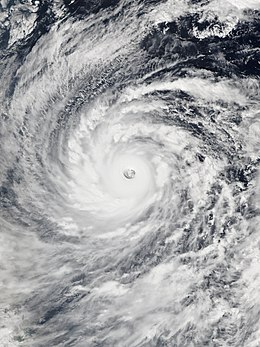Typhoon Vongfong (2014)
| Typhoon (JMA scale) | |
|---|---|
| Category 5 (Saffir–Simpson scale) | |

Typhoon Vongfong at peak intensity on October 8, 2014
|
|
| Formed | October 2, 2014 |
| Dissipated | October 18, 2014 |
| (Extratropical after October 14) | |
| Highest winds |
10-minute sustained: 215 km/h (130 mph) 1-minute sustained: 285 km/h (180 mph) |
| Lowest pressure | 900 hPa (mbar); 26.58 inHg |
| Fatalities | 9 confirmed, 2 missing |
| Damage | $58 million (2014 USD) |
| Areas affected | Caroline Islands, Mariana Islands, Philippines, Taiwan, Japan, South Korea |
| Part of the 2014 Pacific typhoon season | |
Typhoon Vongfong, known in the Philippines as Typhoon Ompong, was the most intense tropical cyclone worldwide in 2014, and struck Japan as a large tropical system. It also indirectly affected the Philippines and Taiwan. Vongfong was the nineteenth named storm and the ninth typhoon of the 2014 Pacific typhoon season. Estimates assess damage from Typhoon Vongfong to have been over $48 million (2014 USD), mainly for the sinking of the Ocean Researcher V. At least 9 people were killed along the path of the typhoon in those countries.
Both the JMA and the JTWC upgraded Vongfong to a tropical storm on October 3. Under low vertical wind shear and excellent outflow, Vongfong intensified into a typhoon east of Guam on October 5. Afterwards, subsidence and moderate to strong vertical wind shear caused the typhoon to struggle to intensify. On October 7, the PAGASA named the system Ompong, while it underwent rapid deepening owing to a TUTT cell. The JTWC then classified Vongfong as the sixth super typhoon of 2014, shortly before reaching peak intensity with a round eye late on the same day.
Maintaining peak intensity for over one day, Vongfong began to gradually weaken on October 9, because of an eyewall replacement cycle. On October 10, the structure of the typhoon decayed more, and it totally lost its eye feature on the next day when passing through Okinawa. Due to mid-latitude westerlies, Vongfong's low-level circulation center became partially exposed. The typhoon accelerated east-northeastward on October 12 and made landfall over Kyushu. The system continued passing through the main islands of Japan and weakened into a severe tropical storm on October 13, before it became extratropical on October 14.
...
Wikipedia
